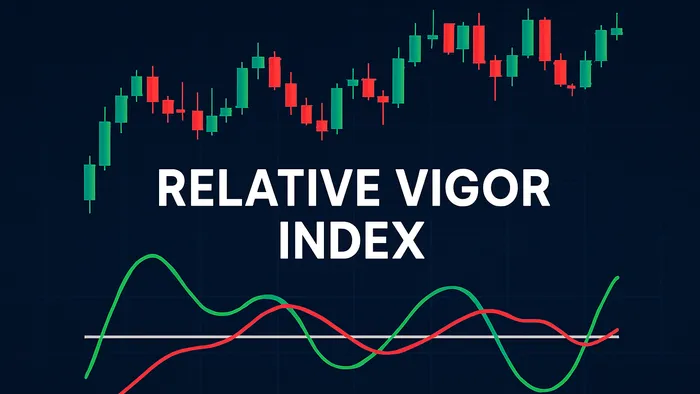Explore the Relative Vigor Index, a momentum oscillator that enhances trading strategies by confirming market trends and momentum shifts.
The Relative Vigor Index (RVI) is a momentum oscillator that helps traders assess market trends by comparing a security's closing and opening prices. It works on the principle that prices typically close higher than they open during uptrends and lower during downtrends. The RVI uses smoothed averages to reduce noise, providing more reliable signals.
Key takeaways:
- RVI Basics: Measures momentum by analyzing closing vs. opening prices, smoothed with moving averages.
- Signal System: Includes a main RVI line and a signal line, which oscillate around a zero line to indicate bullish or bearish trends.
- Trading Signals: Key signals include crossovers (momentum shifts), divergences (potential reversals), and extreme readings (overbought/oversold conditions).
- Use Cases: Best suited for trending markets and liquid assets like major forex pairs, stock indices, and actively traded stocks.
Pro Tips:
- Combine RVI with other indicators like MACD or RSI for stronger confirmations.
- Avoid relying on RVI alone in choppy or low-volatility markets.
- Use resources from LuxAlgo such as the Oscillator Matrix for real-time divergence detection, multi-indicator analysis, and backtesting.
The RVI is most effective as a confirmation tool, offering insights into momentum shifts and trend strength when paired with other analysis techniques.
Relative Vigor Index Trading Strategy [Full Logic + Backtest]
How RVI Works
The Relative Vigor Index (RVI) measures market momentum by analyzing the relationship between closing and opening prices. To start, it calculates a raw value for each period by dividing the difference between the closing and opening prices by the range (High – Low). This raw value can be somewhat erratic, so a simple moving average is applied to smooth out the noise and make trends easier to identify. For additional context on calculation details and typical parameters, see this overview of the Relative Vigor Index.
To further refine the data, a four-period smoothing is commonly used in both the numerator and denominator to reduce short-term fluctuations, producing a more stable main RVI line that highlights broader market trends. The companion signal line is typically derived from a weighted average of recent RVI values (often using weights like 1–2–2–1), creating a two-line system that helps distinguish sustained momentum from short-term noise.
RVI Line and Signal Line
The RVI generates two key lines to help traders identify momentum shifts. The main RVI line reflects the smoothed momentum calculation, often using a 10-period average of the earlier smoothed values. Alongside this, the signal line is calculated by applying a weighted average to the current RVI value and the three preceding values. Together, these lines allow traders to distinguish between longer-term momentum shifts and short-term market noise.
What RVI Readings Mean
The RVI's dual-line system oscillates around a central zero line, reflecting the balance between closing and opening prices. Positive values—where closing prices are higher than opening prices—indicate bullish momentum. Negative values suggest bearish sentiment. The size of these readings can also reveal the strength of the trend, with extreme values sometimes hinting at potential reversals.
This zero-centered framework provides traders with a straightforward way to gauge market sentiment and momentum without unnecessary constraints.
Reading RVI Signals in Trading
Now that we've covered how the RVI is calculated and what its readings mean, let’s dive into how these signals translate into actionable trading insights. Understanding and interpreting RVI signals is key to confirming momentum and deciding when to enter or exit trades.
Main Signal Types: Crossovers, Divergences, and Extremes

Crossovers are among the simplest and most common signals generated by the RVI. When the RVI line crosses above the signal line, it suggests bullish momentum is building. Conversely, when the RVI crosses below the signal line, it points to increasing bearish momentum. These crossovers often align with shifts in market sentiment, making them a useful tool for traders.
Divergences happen when price action and RVI readings move in opposite directions. A bullish divergence occurs when prices make lower lows while the RVI forms higher lows, signaling that selling pressure may be weakening. On the other hand, a bearish divergence arises when prices hit higher highs but the RVI shows lower highs, hinting that buying momentum could be fading. Divergences often act as early indicators of potential trend reversals, giving traders a chance to adjust their positions proactively.
Extreme readings can highlight overbought or oversold conditions. For instance, when the RVI reaches very high positive levels, it may indicate that bullish momentum is overextended, potentially leading to a pullback or period of consolidation. Similarly, very low negative readings suggest that bearish momentum might be running out of steam. However, these extremes should always be interpreted within the context of the prevailing trend to avoid misjudging the market.
The slope of the RVI offers further insight into momentum strength. A steep upward slope indicates accelerating bullish momentum, while a flattening or downward slope may signal that the current trend is losing steam. This can help traders distinguish between strong, sustainable moves and weaker trends that might lack follow-through.
While these signals are helpful, they should be interpreted carefully, as overlooking the broader market context can lead to errors.
Using LuxAlgo's Oscillator Matrix Toolkit

For traders looking to take multi-indicator strategies to the next level, LuxAlgo’s Oscillator Matrix toolkit provides a comprehensive environment. It enhances RVI analysis by integrating multiple oscillator signals and real-time divergence detection in one place.
The toolkit can flag RVI divergences across multiple timeframes. Instead of manually scanning charts, traders can rely on the system to highlight potential reversal opportunities as they develop.
It also excels in combining RVI signals with other oscillators. Readings from multiple indicators—such as the RVI, Stochastic, and Williams %R—can be reviewed together. When several indicators align (e.g., all show bullish conditions), the convergence is immediately visible, simplifying decision-making.
Another key capability is the integration of volume-weighted momentum. This helps differentiate between price movements backed by strong trading activity and those lacking substantial volume. For instance, when RVI momentum aligns with positive money flow, it suggests the move is supported by real trading activity.
Customizable alerts and backtesting options make this toolkit practical. You can set alerts for specific conditions—such as an RVI crossover confirmed by other oscillators—so you don’t miss critical signals. The ability to backtest strategies across assets and timeframes provides a statistical foundation for decisions.
For those using LuxAlgo’s Premium or Ultimate plans, the Oscillator Matrix integrates with features like screening and backtesting. This makes it easy to test RVI-based strategies on various assets and timeframes before applying them live.
References
LuxAlgo Resources
- Momentum Oscillator (Adaptive)
- Understanding Moving Averages
- Trending Market Toolkit
- Oscillator Matrix (OSC)
- Real-Time Divergence Detection
- Moving Averages Proximity Oscillator
- Reversal Spotting Made Easy
- Market Sentiment (Technicals)
- Price Action Concepts (TradingView)
- OSC Reversal Signals (Docs)
- Signals & Overlays Alerts (Docs)
- Backtester — Signals & Overlays
- QQE Weighted Oscillator
- Money Flow Profile
- AI Backtesting








